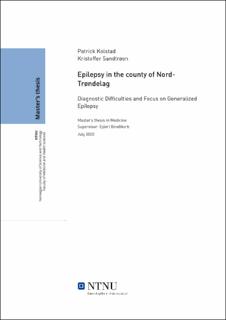| dc.contributor.advisor | Brodtkorb, Eylert | |
| dc.contributor.author | Kolstad, Patrick Bjørn | |
| dc.contributor.author | Sandtrøen, Kristoffer | |
| dc.date.accessioned | 2021-09-13T16:16:07Z | |
| dc.date.available | 2021-09-13T16:16:07Z | |
| dc.date.issued | 2020 | |
| dc.identifier | no.ntnu:inspera:60686860:14470406 | |
| dc.identifier.uri | https://hdl.handle.net/11250/2775940 | |
| dc.description.abstract | Bakgrunn:
Folkehelseundersøkelsen i Nord-Trøndelag (HUNT) er en av de største epidemiologiske studiene som er blitt gjennomført. Studien gir en unik database med helseopplysninger, kliniske målinger og biologisk materiale. For å utføre fremtidige genom-assosiasjonsstudier er diagnosevalidering og kartlegging av kliniske karakteristika nødvendig.
Målsetting:
Å finne andelen pasienter i HUNT-studien med verifisert epilepsi ved å bruke den nye epilepsiklassifikasjonen og se nærmere på feildiagnostisering og pasienter med en usikker epilepsidiagnose, og videre fokusere ytterligere på ulike aspekter ved generaliserte epilepsier i denne populasjonen.
Materiale og metode: Vi identifiserte personer fra HUNT 2- og 3 registrert med epilepsi (ICD-9: 345.x før 1999 eller ICD-10: G40.x etter 1999), med to eller flere opphold på nevrologiske og pediatriske klinikker ved sykehus i Trøndelag fylke. Vi har systematisk gjennomgått pasientene ved hjelp av medisinske journaler. Diagnosen ble validert og klassifisert i henhold til revidert klassifikasjon fra International League Against Epilepsy (2017) ved å bruke en Case Report Form (CRF). Dataene ble videre samlet i EXCEL og analysert i SPSS.
Resultater:
Totalt var det 307 (88,5%) av 347 pasienter som hadde en verifisert epilepsidiagnose. Fokal epilepsi utgjorde størsteparten (80,1%), etterfulgt av generalisert (10,1%), ukjent type (8,3%) og kombinert fokal og generalisert epilepsi (1,3%). Til sammen var det 8.1% feildiagnostiserte pasienter, og 3,5% hadde en usikker epilepsidiagnose.
Konklusjon:
Denne studien bekrefter at feildiagnostisering er et vanlig problem da flere tilstander ligner epilepsi, som oftest synkope og psykiatriske tilstander. Økt kunnskap om de vanligste imitatorene kan bidra til mindre feildiagnostisering. Vi identifiserte en liten og heterogen pasientgruppe hvor epilepsidiagnosen var ukjent. Denne gruppen bør det settes mer fokus på i fremtidige epidemiologiske studier. En relativt høy andel pasienter ble identifisert med epilepsi av ukjent type. Mulige årsaker kan være utilstrekkelig informasjon i legejournaler samt strengere krav i det nye klassifikasjonssystemet. Familieanamnesen bør få oppmerksomhet. Større kunnskap om idiopatisk generalisert epilepsi kan være nyttig i diagnostikken for å skille fokal fra generalisert epilepsi med sen debut. | |
| dc.description.abstract | Background:
The Nord-Trøndelag Health Study (HUNT) is one of the largest epidemiological health studies ever performed. The study provides an exclusive database for questionnaire data, clinical measurements, and biological samples. Validation of the diagnoses and detailed classifications of the epilepsies with mapping of clinical characteristics are mandatory to perform meaningful genotype/phenotype association in future studies.
Aims: To validate the true G.40 diagnosis in the HUNT study cohort according to the revised classification of the epilepsies and explore misdiagnosis rate and patients with an uncertain epilepsy diagnosis, and to further focus on various aspects of generalized epilepsies in this population.
Methods:
We identified subjects from the HUNT 2 and 3 study with two or more appointments at neurological and pediatric clinics recorded with epilepsy (ICD-9: 345.x prior to 1999 or ICD-10: G40.x after 1999) at Hospitals in the county of Trøndelag. We systematically reviewed the patients by reading the medical records. The diagnosis was validated and categorized according to the current classification schemes established by the International League Against Epilepsy (ILAE) by using a Care Report Form (CRF). The data was collected in EXCEL and further analyzed in SPSS.
Results:
In total, 307 (88.5%) out of 347 patients had a valid epilepsy diagnosis. Focal epilepsy accounted for the majority (80.1%), followed by generalized (10.1%), unknown type (8.3%) and combined focal and generalized epilepsy (1.3%). Altogether 8,1% patients were incorrectly diagnosed with epilepsy and 3.5% had an uncertain epilepsy diagnosis.
Conclusion:
The present study confirms that misdiagnosis is a common problem as many conditions resemble epilepsy, most commonly syncope and psychiatric conditions. Enhanced knowledge of the various imitators of epilepsy can contribute to lower misdiagnosis rates. We identified a small and heterogenous group of patients with an uncertain epilepsy validation. This patient group should be further acknowledged and investigated in other epidemiologic studies on epilepsy. A relatively high share of patients was identified with unknown type of epilepsy. This could be due to insufficient information in medical records and stricter classification criteria. A family history of epilepsy should be addressed. Enhanced knowledge on idiopathic generalized epilepsy, might be helpful to differentiate focal from adult onset generalized epilepsy. | |
| dc.language | | |
| dc.publisher | NTNU | |
| dc.title | Epilepsy in the county of Nord-Trøndelag
- Diagnostic Difficulties and Focus on Generalized Epilepsy | |
| dc.type | Master thesis | |
